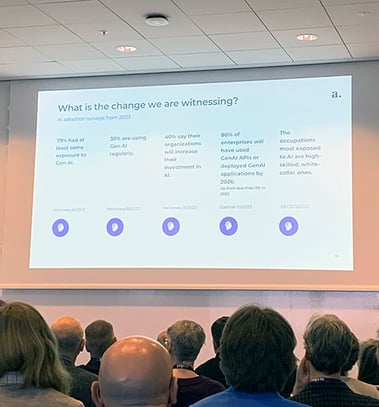I attended NORDIC TechKomm: The Conference on User Experience and Technical Communication on March 6th-7th, 2024 in (delightfully sunny & bone-chillingly windy) Stockholm, Sweden. Over the two days, a wide range of topics was covered, including using analytics to quantify the ROI of technical documentation, creating custom icons and other visual enhancements to documentation, as well as tactics for overcoming language hurdles.
However, from my viewpoint, the most interesting (and incidentally also somewhat controversial) presentations and discussions were centered around AI usage in technical communication. Below are some of the key takeaways & some musings on how they relate to my work at Solteq.

The Future is Already Here
Like it or not, Artificial Intelligence is already molding the way technical communicators need to devise their strategies and processes, plan their work, and perform their content creation tasks. There are no foreseeable future scenarios where AI is not involved in technical content production, which means that for technical communicators, the current situation presents a watershed moment: Now is the time to devise the ways that we ourselves can steer the future of our profession in AI-infused world.
Some AI usage examples I personally am envisioning in our documentation include document summaries, automatic translation and chatbot answersto provide more flexible, personalized and quick ways to utilize user documentation for our Solteq Tekso and Solteq Commerce Cloud customers. Again, I would love to hear feedback from our customers on not only the current state of our documentation, but also what are their future expectations regarding online help, manuals, and such.
The options for AI usage in technical communication are increasing each day. However, before AI usage is implemented, there also needs to be a profound discussion and analysis regarding what human expertise should be augmented and/or replaced with AI in technical communication processes (more on that later). The extent of AI usage in a given documentation process also depends on the intended outcome and the projected result; the less refined the end product needs to be, the more easier it might be to produce it with AI.
AI in All Phases
Based on the presentations I witnessed, AI can be utilized in all phases of the documentation lifecycle, whether it be in planning, content creation, quality assurance, publishing, and/or supporting users. However, this requires analysis to envision the intended outcome of utilizing AI in each phase: Is the goal to save time & resources, make some processes automatic, increase customer satisfaction... or perhaps all of the aforementioned? One important issue to consider is also that AI can be introduced gradually into the different phases to enable evaluating its usefulness, and then make adjustments as needed; not everything needs to be overhauled at once.
In my own work I am currently evaluating the key points where AI could be utilized in technical documentation processes, as well as experimenting with various options. This is not a simple undertaking, as it requires a throughout analysis of every step of information production and maintenance. In my experience, the results for using machine-aided translation (for instance) have been very good in some areas - such as translating requirement specifications and contract templates - that is, texts with very standard format and language. In some other areas the end results have been lacking a bit - mostly due to very specialized vocabulary used in e-commerce related issues, for example. However, I remain solidly optimistic about the future prospects of using AI in several phases of the documentation work, and will continue to analyze our current processes to find modern, user-friendly solutions.
It's All About the Quality
Since AI utilizes existing information to generate content,>the information must be quality-wise mature enough to be utilized. This means that the corpus of technical data must be structured and formatted to be AI-friendly. One interesting question is that should AI-generated content be marked as such in the text, since out of necessity it does not go through the same quality assurance processes as human-generated content?
I feel that at Solteq we are now approaching the technical readiness to utilize AI technology more and more in documentation work, which means that the documentation at large is sufficiently well-organized and of sufficient quality for AI tool usage (see examples of our current online manuals for Solteq Commerce Cloud manual and Solteq Tekso manual.
In addition, the tools we currently use for both internal and customer documentation (Atlassian Confluence, Jira, and assorted add-ons) are easy to integrate to various systems which utilize AI technology in an information-secure and agile manner.
Do you have questions/comments regarding Solteq's documentation? Feel free to contact me pekka.pietikainen@solteq.com.









